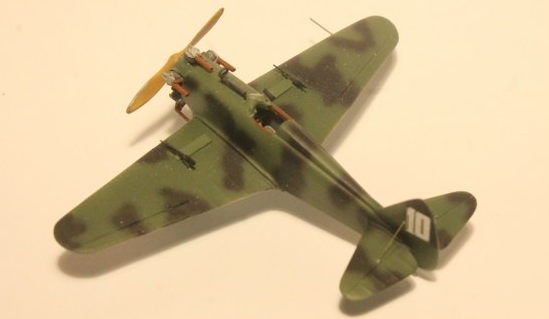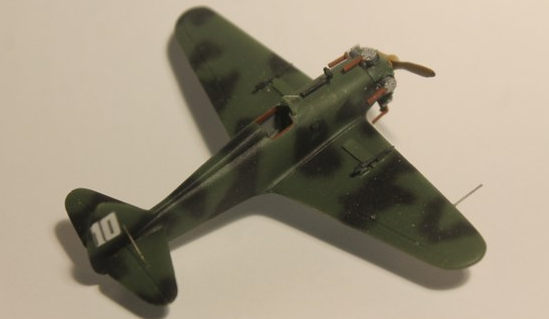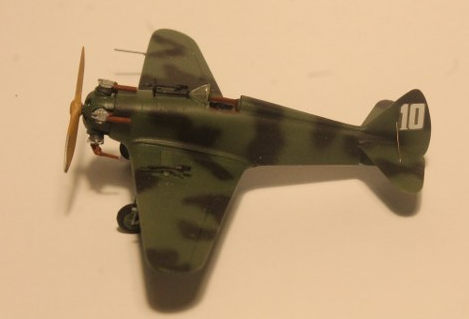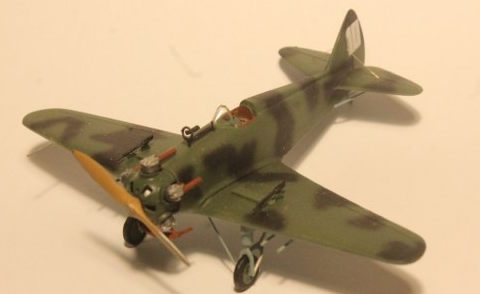
Pavla 1/72 Yak UT-1
| KIT #: | 72034 |
| PRICE: | ~$20.00 |
| DECALS: | Four Options |
| REVIEWER: | Brian Baker |
| NOTES: | A VERY small aircraft, but also very interesting |

| HISTORY |
The Yakovlev
UT-1 was developed by a design team led by K.V. Singlecikov as a single seat
light aircraft for training fighter pilots in basic combat tactics. Although
the prototype was powered by a 100 hp. M.11 5 cylinder radial engine,
production models had the more powerful 115 hp. M-11G and later the 150 hp.
M.11E
 engine. Production began in 1936, and a total of 1241 of all variants
was produced.
engine. Production began in 1936, and a total of 1241 of all variants
was produced.
Most UT-1’s were delivered directly to fighter pilot schools, although the airplane’s performance, (It must have been a lot of fun to fly) led to its acquisition by various high level unit commanders as a “hack” airplane. During the war, the Naval Air School Technical Workshops converted approximately 25 tol armed interdiction aircraft, with two ShKas 7.62 mm. machine guns mounted above the wings, and rails for four RS082 rocket missiles under the wings, These were designated UT-1b, and were used by the 23rd and 46th Air Wings of the Black Sea Fleet for night interdiction and nuisance attacks during the summer of 1942. Later, the Yakovlev OKB built an armed version which had a longer fuselage, a larger vertical stabilizer, and one or two ShKas machine guns mounted in the nose. One of these enlarged UT-1’s survived the war , and is preserved in the Yakovlev Museum. This aircraft can be built from the kit, using the alternate fuselage provided.
Pavla does a
fine job of providing excellent instructions and assembly drawings for this
kit. The instructions consist of four standard sheets containing a good
historical sketch in Polish and English. A useful sprue
 diagram, 6 pages of
assembly drawings, and six sheets of four view drawings for camouflage and
marking information. Decals are provided for four aircraft, including;
diagram, 6 pages of
assembly drawings, and six sheets of four view drawings for camouflage and
marking information. Decals are provided for four aircraft, including;
1. UT-1b, #47025, White 10, flown by Sgt. V>V> Prozer, 46th Air Wing, Gaidvic Airfield, used for night attack, 1942 through 1944.
2. UT-1b White 4, Tested on skis by 23rd Air wing, 1942.
3. UT-1.02 Prototype. Rebuilt and exhibited at Yakovlev OKB Museum.
4. UT-1. Red 2. Used by high ranking officers of Western Aviation Region, probably 1940 Unarmed, but ij brilliant white and red scheme and wheel pants.
| THE KIT |
 The kit
consists of 31 injection molded parts, (not all will be used), one
vacuform
canopy (two types), and 12 resin parts. Surface detail is light but very
realistic, and there is some flash to be trimmed, but nothing a moderately
skilled modeler can’t handle. Extra parts are easily identified, and
drawings show which parts are to be used on each specific variant. A few
small items need to be scratchbuilt, and some struts must be fabricated from
plastic rod or strip, although instructions are clearly given, with
dimensions provides in mm. The kit appears to be very accurate, although I
am using only the kit instructions for reference. I assume that they used
the museum airplane for reference.
The kit
consists of 31 injection molded parts, (not all will be used), one
vacuform
canopy (two types), and 12 resin parts. Surface detail is light but very
realistic, and there is some flash to be trimmed, but nothing a moderately
skilled modeler can’t handle. Extra parts are easily identified, and
drawings show which parts are to be used on each specific variant. A few
small items need to be scratchbuilt, and some struts must be fabricated from
plastic rod or strip, although instructions are clearly given, with
dimensions provides in mm. The kit appears to be very accurate, although I
am using only the kit instructions for reference. I assume that they used
the museum airplane for reference.
| CONSTRUCTION |
 Kit assembly is
very straightforward. The cockpit is well detailed, with some resin parts needed
for the seat, etc. The engine is nicely detailed, with very realistic exhausts
and prop. The wing underside is cast in one piece, while the upper halves simply
are glued to the underside. When attached to the fuselage, the dihedral angle is
completely correct. The tail unit consists of one piece elevator-stabilizer
combinations, and the different types of landing gear are easy to install.
Wheels, pants, and skis are provided, along with the external armament. The kit
goes together quickly, although I would advise painting the cockpit interior
parts before fuselage assembly.
Kit assembly is
very straightforward. The cockpit is well detailed, with some resin parts needed
for the seat, etc. The engine is nicely detailed, with very realistic exhausts
and prop. The wing underside is cast in one piece, while the upper halves simply
are glued to the underside. When attached to the fuselage, the dihedral angle is
completely correct. The tail unit consists of one piece elevator-stabilizer
combinations, and the different types of landing gear are easy to install.
Wheels, pants, and skis are provided, along with the external armament. The kit
goes together quickly, although I would advise painting the cockpit interior
parts before fuselage assembly.
| COLORS & MARKINGS |
A good variety of color schemes can be used on this model. The first two aircraft used standard Russian dark green and black topsides and light blue undersides. The third plane, the museum example, has dark green over light blue, and is unmarked except for the rudder stripes. The fourth choice is the “Generals’ Barge”, with a striking red and white color scheme.
| CONCLUSIONS |
This is a very nice little model. It is small, and approximates the many American homebuilts that appeared after World War II, and I’m surprised that nobody has build a flying replica so far. Maybe someday….
The model fills a gap in my collection, and was certainly a pleasure to build. I am not sure of the availability of the kit today, since I bought and built my kit in 2006, but I’m sure it is available somewhere. Get one if you can. Building it was a blast! Highly recommended.
13 December 2019
Copyright ModelingMadness.com
If you would like your product reviewed fairly and fairly quickly, please
contact
the editor
or see other details in the
Note to
Contributors. Back to the Main Page
Back to the Review
Index Page
Back to the Previews Index Page